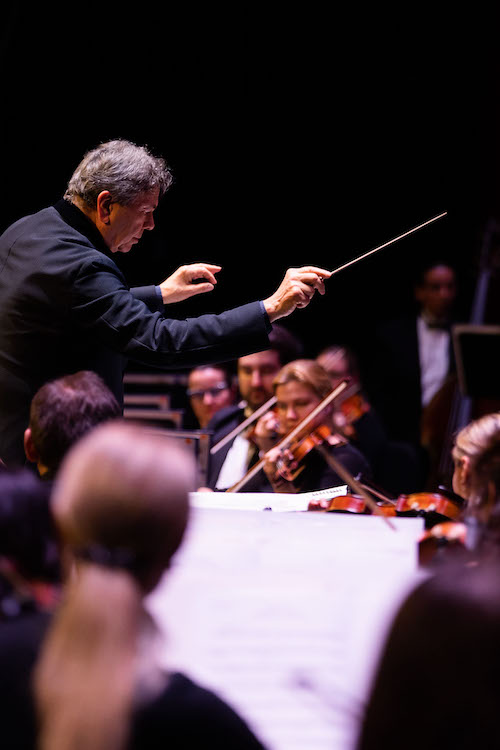An evening of light arias and dark Shostakovich with the Palm Beach Symphony

Susan Graham performed songs and arias with the Palm Beach Symphony Monday night at the Kravis Center. Photo: Photo: Matthew Cosgrove
The renowned mezzo-soprano Susan Graham joined the Palm Beach Symphony Monday evening for a program that ranged from popular songs to one of the greatest symphonies to emerge from the Soviet Union.
The concert at the Kravis Center in West Palm Beach had a pops concert feel with a parade of arias and light music—until a symphony by Dmitri Shostakovich arrived to darken the mood. After the orchestra under conductor Gerard Schwarz cleared its throat with a brisk account of Mozart’s Overture to The Marriage of Figaro, Graham took the stage and conquered the audience with a charismatic stage presence and a voice that has shown impressive longevity.
A highlight was her performance of a pair of arias sung in the role of Cherubino from the Marriage of Figaro, one of her signature trouser roles. In “Non so più” she expressed the emotional, hormonal turbulence of an adolescent boy who is obsessed with women.
If her voice sounded a bit thinner at the top, it remained plush, focused and commanding. In “Voi, che sapete,” Cherubino’s other aria, most striking was the quieter repetition of the melody, where her effortless tone production allowed her to produce elegant phrases that filled the hall. She displayed the same qualities In “Deh per questo istante solo” from Mozart’s La Clemenza di Tito.
To sing “Vilja,” the most famous aria from Franz Lehár’s The Merry Widow, she draped a black scarf over her orange gown and gave a warmly lyrical account of the famous melody. She invited the audience to sing the choruses, giving out each phrase in advance, and a large number of people gamely participated.
Graham is renown in French repertoire, as was clear in “Ah! Ah! je vais mourir…Adieu, fière cité” from Berlioz’s Les Troyens, which seemed just right for her voice. With unforced power and plushness, she expressed the fortitude and courage of a woman going with open eyes to her death.
After a break, she came out, picked up a microphone and sang three popular songs: Gershwin’s “Fascinating Rhythm,” Rodgers’ “The Sound of Music” and as an encore, “Climb Every Mountain.” Although the electronic assistance wasn’t always flattering, making her voice louder but thinner, she knew how to bring off these songs, singing with jaunty high spirits in the Gershwin, and with husky bravery and determination in “Climb Every Mountain.”
The arias came off with skillful, unobtrusive support from Schwarz and the orchestra that kept the focus firmly on the singing.
In between Graham’s set of arias and her performance of popular songs, the orchestra played Debussy’s Prélude à l’après-midi d’un faune. If the performance was to serve simply as a place-saver to let Graham rest her voice, it was still a fine account, with luminous playing in winds and strings, and a natural flow to the shimmering music.

Gerard Schwarz conducted the Palm Beach Symphony in Shostakovich’s Symphony No. 10 Monday night at the Kravis Center. Photo: Indie House Films
Although Graham may have been the star of the evening, the finest music-making came in the second half in one of Shostakovich’s greatest symphonies.
Like millions of Soviet citizens in the age of Stalin’s terror, Shostakovich lived in fear of the 3 a.m. knock on the door. His Symphony No. 10, according to some sources, reflected the grimness of Stalin’s rule, complete with a brutal second-movement portrait of the leader himself. Other accounts deny these were Shostakovich’s motives in composing the symphony, and musical historians still argue about it.
Schwarz, in brief remarks before the performance, described the symphony’s ambiguous meaning and said he sided with those who see the symphony as inspired by Stalin’s brutality. Either way, he led a superb performance of a work that typically runs 50 minutes or longer. Expansive and unhurried, Monday night’s account captured the work’s breadth and grandeur, creating a dark sea of orchestral sound against which Shostakovich’s bursts of energy arrived like shellbursts and lightning strikes.
The opening Moderato, from its grim opening in the lower strings, unfolded in an ominous, suspenseful manner. With spidery wind melodies and a sense of impending crisis, Schwarz led the orchestra through a long crescendo, with the formal boundaries of the music seeming to unravel, as military-sounding snare drum, shrieking woodwinds, brass and strings created a hellish soundscape.
The ensuing Allegro was one of those manic Shostakovich movements, with Schwarz wringing every bit of crudity and vulgarity from the swaggering music to portray the man it appeared to depict. Virtuoso string playing gave the movement an extra jolt of energy.
The Allegretto came off as almost comic in its creepiness, with fine playing in horn calls signaling a turn in which the music deepens, slows and darkens. The finale was marked by fine solos in the wind instruments, in which the musicians played in the personal and expressive manner of arias, before Schwarz led the orchestra to a jubilant finale in a triumph over the darkness.
The Palm Beach Symphony’s next performance will be 8 p.m. March 14, with Gerard Schwarz conducting and Misha Dichter as piano soloist. The program will include Stravinsky’s The Firebird, the world premiere of Joseph Schwantner’s Sojourn: Reflections on Thoreau, and Gershwin’s Concerto in F. palmbeachsymphony.org
Posted in Performances
Leave a Comment
Tue Jan 31, 2023
at 12:07 pm
No Comments






